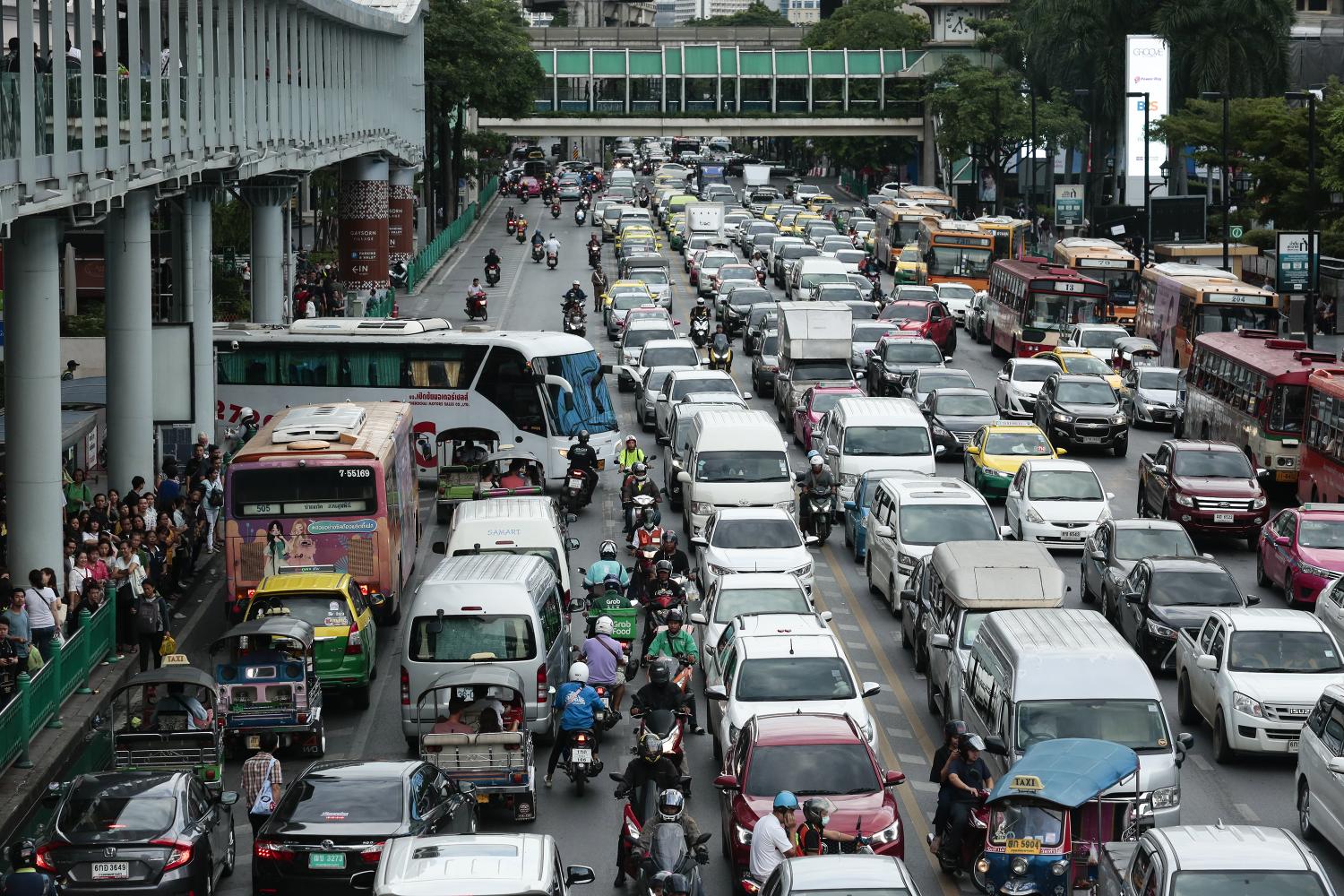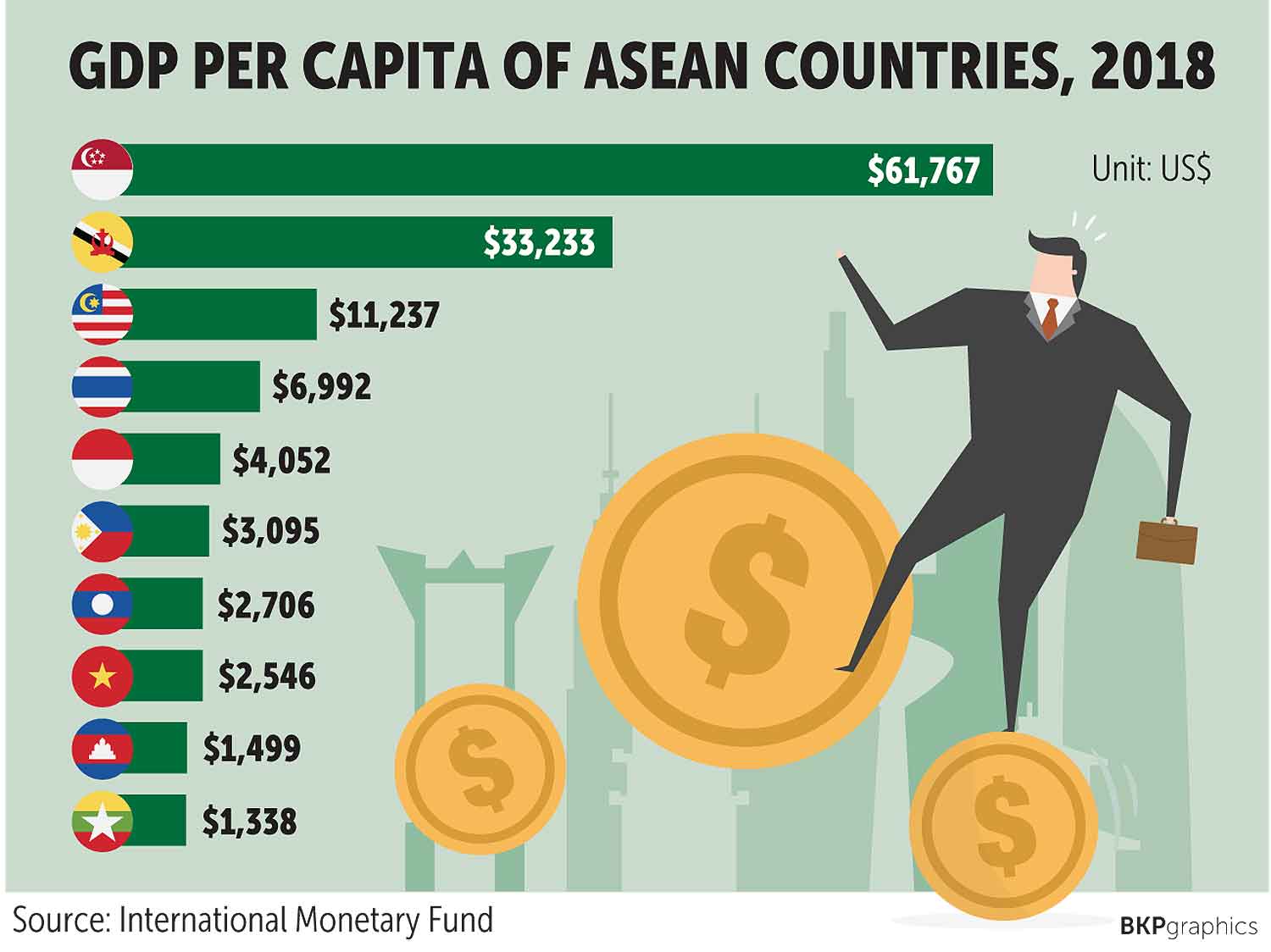
Prime Minister Prayut Chan-o-cha's speech at the 74th session of the UN General Assembly in New York was chock-full of talking points, but the one that stood out was his declaration that Thailand would become a rich country by 2036.
"Thailand will become a high-income country with fairness, respect for basic human rights and participation in all sectors of society," Gen Prayut said, according to the US-Asean Business Council.
The remark bears no relation to the current reality, and analysts question whether Southeast Asia's second-largest economy can vault from a middle-income trap to the high-income segment within 17 years.

Cars are trapped in a typical traffic jam on a Bangkok street. Patipat Janthong
TWO DECADES
Thosaporn Sirisamphand, secretary-general of the National Economic and Social Development Council (NESDC), said the prime minister's remark came as no surprise, as the lofty goal is stipulated in the country's 20-year national strategy (2017-37).
The government's 20-year plan calls for closing the widening income gap in the country to 15 times within 20 years, down from 20 times.
Particularly, the plan focuses on the richest 10% and the poorest 10%.
To reduce the income gap, the state will focus on income distribution, economic development and legislative reform to give low-income groups access to education, economic opportunity and justice.
The government also aims to raise per capita income to US$15,000 (467,384 baht), with average GDP growth of 5-6%. The plan further entails raising competitiveness so that Thailand can break into the global top 20 on that score.
Thailand's per capita income was close to $7,000 a year in 2018, and the country ranked 30th in the IMD World Competitiveness rankings, slipping from 27th in 2017.
The country's national strategy comes with 23 master plans. Under those plans, there are 15 urgent flagship projects that must be implemented during 2019-23.
The 15 projects are split into several groups: social and economic restructuring in an effort to increase Thai competitiveness; upgrading Thais' skills; projects that can create a balance between social and economic growth; infrastructure projects that can drive long term economic growth; and projects that can generate income to create sustainable growth.
The first five years (2019-23) of development are based on requirements set under the national strategy plan. Gross national income per capita is targeted to increase by an average of 70,000 baht a year to reach 360,000 baht in 2023, up from 290,000 baht in 2019.
Growth in agriculture, industry and services/other is targeted at 3.8%, 4.6% and 5.4%, respectively, in the 12th national plan.
"To become a developed or rich country, the country's national economic and social development plans are key tools to enable the country to reach that ambitious goal," Mr Thosaporn said.
Nonetheless, the government may need to revise the master plan to suit the changing situation. The country's economy may grow by just 3% this year, and the US-China trade war is manifesting as a key threat to global trade.
Mr Thosaporn noted that several developed countries, including the US, still have poor people.
The agency hopes that by the end of the national strategy plan no Thais will be left below the poverty line.
There were 7.87 million Thais living below the poverty line, defined as an income of 2,686 baht a month, in 2017, down from 34.1 million in 1991.

A homeless man sleeps on the pavement across the street from Hua Lamphong railway station. There were 7.87 million Thais living below the poverty line in 2017. Pawat Laopaisarntaksin
'WORTHY GOAL'
Yunyong Thaicharoen is the first executive vice-president and head of the Economic Intelligence Centre at Siam Commercial Bank.
"Setting a long-term target for Thailand to become a high-income country by 2036 is a challenging but worthy goal," Mr Yunyong said.
According to the World Bank's definition, Thailand needs to almost double gross national income per capita from $6,610 in 2018 to $12,376, which is the current threshold for high-income country (HIC) status.
"Assuming, for simplicity, a similar trend for inflation and exchange rate changes for both Thailand and HICs over the next 17 years, the economy must grow by 3.5% per annum on average to reach HIC status by 2036," Mr Yunyong said.
While theoretically this rate of growth is possible, the 3% growth figure of the past five years indicates that challenges lie ahead.
"First, the shrinking labour force as the population ages will slow down the overall growth rate," Mr Yunyong said. "The NESDC projected that the Thai labour force [people aged 15-60 years old] would decline roughly by 1% per year over the next 17 years.
"Second, Thailand does not have capital deepening. Capital per labour has been declining over the past decade, as reflected by low investment in GDP at 23.8% during 2016-18, the lowest among Asean peers."
Finally, overall productivity improvement continues to be hampered by poor infrastructure for the digital future, as reflected by a relatively low IMD competitiveness ranking in terms of scientific and education infrastructure.
"I believe that a three-dimensional strategy will be required for Thailand to achieve HIC status by 2036," Mr Yunyong said. "The most important thing is supply-side policy to improve human capital and innovation.
"Second, we need to boost sustainable demand, especially in the form of private investment, as well as government spending on education and health, particularly for lower-income households."
Last but not least, an effective digital strategy to promote digitalisation among businesses, especially small and medium-sized enterprises, is essential.
"This balanced strategy will not only enhance overall economic growth, but also help mitigate the problem of rising inequality as well," Mr Yunyong said.

The view from the Mahanakhon Skywalk at one of Thailand's tallest buildings spans downtown Bangkok. Wisit Thamngern
EEC FLAGSHIP
Industry Minister Suriya Jungrungreangkit said the government initiated the Thailand 4.0 policy with the aim of unshackling the country from several economic challenges that were compounded by previous development models, namely agriculture-focused (Thailand 1.0), light industry promotion (Thailand 2.0) and advanced industry (Thailand 3.0).
"These challenges have put Thailand in the middle-income trap," Mr Suriya said.
Thailand's industrial sector accounts for 30% of GDP. The government is developing a new growth hub, starting with the Eastern Economic Corridor (EEC) in Chachoengsao, Chon Buri and Rayong provinces.
"The EEC is a critical policy to push the economy into the future through advanced technologies and innovations under the S-curve scheme," Mr Suriya said.
The EEC is expected to beef up Thailand's GDP to expand by an extra 2% a year. If Thailand wants to overcome the middle-income trap, the country's GDP should grow by 6.4% on average for the next 10 years, Mr Suriya said.
"New target industries under the S-curve scheme will provide an avenue for escaping the middle-income trap in the future," he said.
Montri Mahaplerkpong, vice-chairman of the Federation of Thai Industries, said the Thailand 4.0 scheme can increase household income in the future as the government looks to the model to push forward local economies.
"New target industries will increase Thailand's industrial efficiency and competition while upgrading industrial value chains," he said.
Mr Montri said Thailand should work on raising the bar for skilled workers to serve the new targeted industries, but the country has been suffering from a skilled labour shortage.
Thailand has 38.1 million labourers and an unemployment rate of 1%.
The demand for skilled workers is larger than for unskilled people because skilled workers can benefit the overall labour market, Mr Montri said.
"Productivity is driven by skill levels, education and training, and the use of technology," he said.
Companies have agreed to pay higher wages for skilled workers, Mr Montri said.
"This means they will have higher income to improve their quality of life, while the labour market on the whole will gain in value for industrial chains and increase the country's GDP per capita," he said.
"Thailand's GDP needs to expand by more than 3% annually to enable further growth in global trade and investment, while Thais must be equipped with skills to serve the advent of innovative industries."
